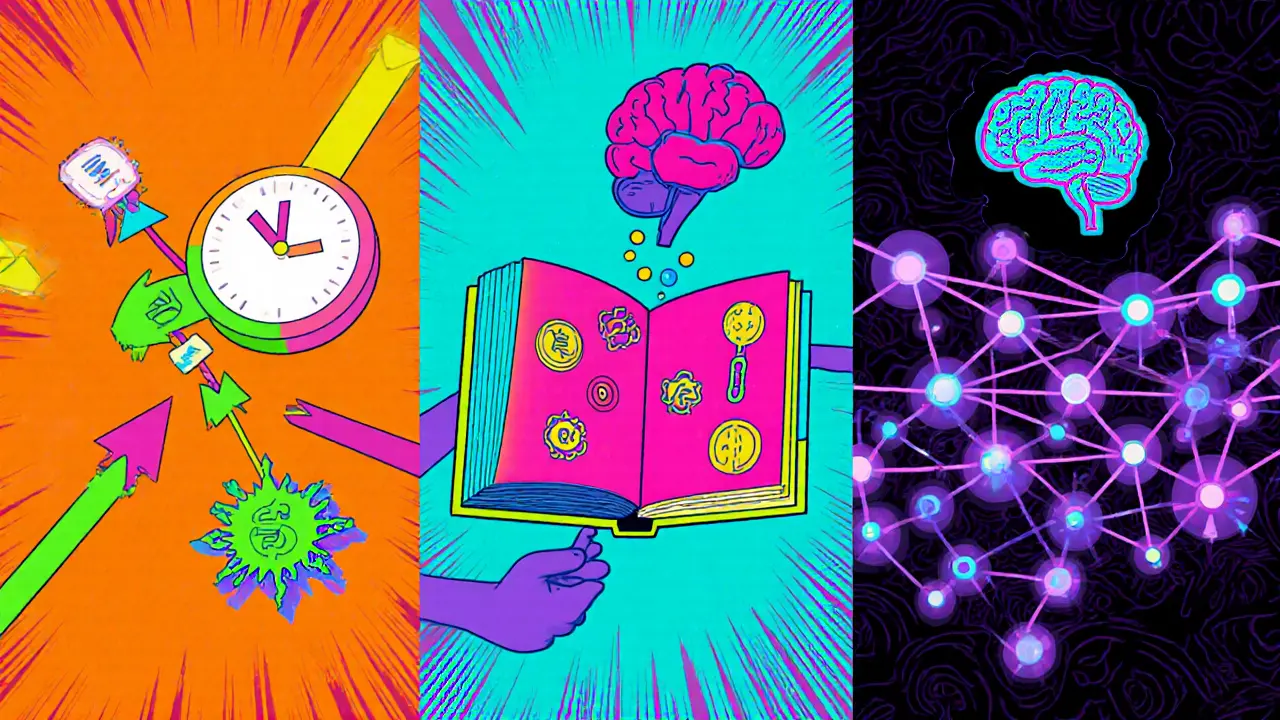Tracing Method Selector Tool
Select Your Tracing Scenario
When a crypto wallet moves funds across a public ledger, the trail is visible to anyone with a blockchain explorer - but making sense of that trail takes more than a quick glance. On-chain crypto transaction tracing is the systematic process of following and analyzing those on‑chain movements to uncover patterns, link addresses to real‑world entities, and flag suspicious activity.
Why tracing matters in 2025
Illicit crypto activity still represents a tiny slice of overall volume - about 0.34% of transactions in 2024 according to Chainalysis - yet the impact is outsized. Money‑laundering rings, ransomware payouts, and fraud schemes all rely on the ability to hide funds. At the same time, banks, exchanges, and even DeFi protocols need tracing to meet AML obligations and to protect investors. The global blockchain analytics market, valued at $1.87 billion in 2024, is projected to reach $7.43 billion by 2029, underscoring how essential these techniques have become.
Core methodologies
Tracing can be grouped into three main families. Each has its sweet spot, limitations, and typical use‑cases.
Heuristic‑based techniques
Heuristic‑based tracing relies on simple rules derived from transaction properties - timestamps, gas fees, address reuse, or known exchange deposit addresses. Early tools from Chainalysis (founded 2014) and Elliptic (2013) used these methods to flag “large‑to‑small” fund splits, known as peel chains.
- Best for single‑chain investigations where the flow is relatively straight‑line.
- High accuracy on Ethereum (≈89% in 2024) but drops to around 63% when hops cross to other chains.
- Fast and low‑resource - can run on a laptop in minutes.
Rule‑based detection
Rule‑based systems extend heuristics by building a library of detection patterns. For example, Nansen’s 2025 analysis showed a 92% success rate at catching peel chains by monitoring repeated address clustering and token‑swap events.
- Requires continuous rule updates as criminals evolve their tactics.
- Excels at spotting specific fraud patterns like dusting attacks or synthetic address reuse.
- Often bundled into commercial platforms (Elliptic, TRM Labs).
Graph learning‑based approaches
Graph learning‑based tracing treats the blockchain as a massive graph, where nodes are addresses and edges are transactions. Machine‑learning models - graph neural networks, attention‑based encoders - can detect subtle, multi‑hop patterns that evade simple rules.
- Most promising for complex, cross‑chain scenarios (85% accuracy for 2‑3 hop tracing per Merkle Science, 2024).
- Needs substantial compute, curated training data, and expertise in ML.
- Still vulnerable to privacy‑coin obfuscation (Monero, Zcash) and advanced mixers.
Side‑by‑side comparison
| Method | Typical Accuracy | Best Use‑case | Key Limitation | Resource Cost |
|---|---|---|---|---|
| Heuristic‑based | ≈89% (single chain) / 63% (cross‑chain) | Simple fund‑flow tracking on Ethereum, BSC | Fails when hops exceed 2‑3 chains | Low - can run on standard hardware |
| Rule‑based | ≈92% for peel‑chain detection | Pattern‑specific fraud (dusting, address reuse) | Rules become stale quickly | Medium - requires rule‑engine platform |
| Graph learning‑based | ≈85% for multi‑hop across 2‑3 chains | Complex laundering schemes, cross‑chain bridges | High compute, heavy data prep, less effective on privacy coins | High - GPU clusters or cloud ML services |

Tools of the trade
Whether you’re a compliance officer or an independent researcher, the market offers a range of solutions - from free explorers to enterprise‑grade suites.
- Etherscan and Blockstream Explorer: basic blockchain explorers for quick look‑ups.
- BlockSci: open‑source library for bulk transaction parsing.
- Chainalysis Reactor, Elliptic Lens, TRM Labs Radar: commercial platforms that bundle heuristics, rule libraries, and some graph features.
- Nansen and Merkle Science: specialize in address clustering and AI‑driven pattern detection.
- Arkham Intelligence: provides a community‑driven graph view with API access.
Pricing varies widely - a single analyst seat can run $15,000‑$50,000 per year for the heavyweight suites, while cross‑chain add‑ons push the cost toward $27,500 annually.
Practical workflow for an analyst
- Identify the target address or transaction hash.
- Pull raw data from a blockchain explorer (e.g., Etherscan) and import it into a parsing tool like BlockSci.
- Apply heuristic filters - look for large inbound transfers, known exchange hot‑wallets, or suspicious timestamps.
- Run rule‑based checks for known patterns (peel chains, dusting).
- If the flow jumps to another chain, switch to a cross‑chain capable platform (TRM Labs supports 47 chains as of 2025).
- For complex, multi‑hop cases, feed the transaction graph into a graph‑learning model (e.g., a GNN built on PyTorch Geometric).
- Correlate on‑chain findings with off‑chain data - KYC records from exchanges, IP logs, or sanction lists.
- Document the chain of evidence and flag any unresolved hops for expert review.
Training typically takes 3‑6 months of hands‑on practice, according to Arkham’s 2024 guide. You’ll need a solid grasp of transaction structures, familiarity with smart‑contract events, and an eye for common obfuscation tricks.

Regulatory backdrop shaping the field
The 2019 FATF Travel Rule forced virtual‑asset service providers (VASPs) to collect originator and beneficiary info for transfers above $1,000. That alone spurred a surge in analytics adoption - from a $200 million market in 2019 to $1.87 billion in 2024. Europe’s MiCA regulation and the U.S. Executive Order 14067 have pushed exchanges to embed blockchain analytics directly into their transaction pipelines; a 2025 CipherTrace survey found 87% of exchanges now run real‑time tracing solutions.
At the same time, privacy advocates warn against overreach. Jeremy Gillula of the EFF cautioned in 2024 that “tracing tools must not become mass surveillance instruments.” Balancing compliance and privacy remains a hot policy debate.
Emerging trends and the arms race
Graph learning is the next frontier. Researchers at MIT and Stanford are publishing novel GNN architectures designed specifically for transaction graph analysis. Gartner predicts that by 2027, 70% of enterprise analytics platforms will bundle generative‑AI‑driven anomaly detection.
Cross‑chain tracing is also improving. TRM Labs added support for 15 more networks in early 2025, making it easier to follow funds from Ethereum → BSC → Tron without manually swapping tools. Yet privacy‑focused coins like Monero and Zcash still account for over 7% of illicit volume, and decentralized mixers now represent 18.3% of suspicious flows.
In practice, the best approach is hybrid: start with fast heuristics, layer in rule‑based pattern filters, and reserve graph‑learning models for the hard‑to‑solve cases. When the trail becomes too tangled - multiple simultaneous hops or obscure chains - bring in specialized experts or premium platforms.
Bottom line
On‑chain crypto transaction tracing isn’t a magic bullet, but it’s a powerful set of lenses that turn pseudonymous ledgers into actionable intelligence. Master the basics, know the limits of each method, and stay ahead of the evolving obfuscation tactics, and you’ll be able to spot illicit moves before they disappear.
What is the difference between heuristic‑based and rule‑based tracing?
Heuristic‑based tracing applies simple, generic rules such as “large‑to‑small transfers” and works well for clear, single‑chain flows. Rule‑based tracing builds a library of specific patterns (e.g., peel chains, dusting attacks) that need regular updates as criminals change tactics.
Can on‑chain tracing identify the real person behind an address?
Not on its own. Tracing can cluster addresses and flag likely owners, but definitive attribution requires off‑chain data like exchange KYC records. As Dr. Sarah Meiklejohn notes, the attribution problem remains fundamentally unsolved without external evidence.
How effective are graph learning models against privacy coins?
Their effectiveness drops sharply. While they can achieve up to 85% accuracy on multi‑hop Ethereum‑BSC‑Tron flows, privacy‑focused networks like Monero hide amounts and addresses, limiting graph‑based detection to roughly 20‑30% success unless additional metadata is available.
What tools are free for a beginner wanting to practice tracing?
Start with public explorers such as Etherscan (Ethereum) or Blockstream Explorer (Bitcoin). For bulk analysis, BlockSci is an open‑source Python library you can run locally. Combine those with simple spreadsheet work to map address clusters.
How does the FATF Travel Rule impact tracing workflows?
It forces VASPs to collect and share originator/beneficiary details for transfers over $1,000. That data, when combined with on‑chain analysis, lets investigators move from a pseudonymous address to a known entity, dramatically improving AML compliance.

Write a comment